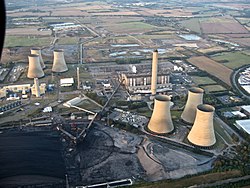Didcot A Power Station
| Didcot Power Stations | |
|---|---|

Didcot Power Station
Viewed from the south in September 2006 |
|
| Country | England |
| Location | Oxfordshire, South East England |
| Coordinates | 51°37′25″N 1°16′03″W / 51.62363°N 1.26757°WCoordinates: 51°37′25″N 1°16′03″W / 51.62363°N 1.26757°W |
| Commission date | 1968 |
| Operator(s) |
Central Electricity Generating Board (1968-1990) National Power (1990-2000) Innogy plc (2000-2002) RWE npower (2002-present) |
| Thermal power station | |
| Primary fuel | Coal |
| Secondary fuel | Natural gas |
| Tertiary fuel | Biofuel |
| Power generation | |
| Nameplate capacity | 3,360 MW |
| grid reference SU508919 | |
Didcot Power Stations consist of an active natural gas power plant (Didcot B Power Station) that supplies the National Grid, and a closed combined coal and oil power plant (Didcot A Power Station). They are situated immediately adjoining each other in the civil parish of Sutton Courtenay, next to the town of Didcot in Oxfordshire, England.
A large section of the boiler house at Didcot A power station collapsed on 23 February 2016 while the building was being prepared for demolition. Four men were killed in the collapse.
The combined power stations feature a chimney which is one of the tallest structures in the UK, and three hyperbolic cooling towers (three others were demolished in 2014), which can be seen from much of the surrounding landscape.
Didcot A Power Station was a coal and gas-fired power station designed by architect Frederick Gibberd. Construction of the 2,000 MWe power station for the Central Electricity Generating Board began during 1964, and was completed in 1968 at a cost of £104m, with up to 2,400 workers being employed at peak times. It was located on a 300 acres (1.2 km2) site, formerly part of the Ministry of Defence Central Ordnance Depot. A vote was held in Didcot and surrounding villages on whether the power station should be built. There was strong opposition from Sutton Courtenay but the yes vote was carried, due to the number of jobs that would be created in the area.
...
Wikipedia

